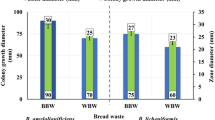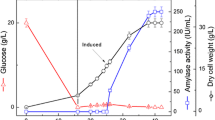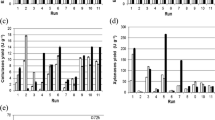Abstract
Production of α-amylase under solid-state fermentation by Bacillus brevis MTCC 7521 has been investigated using cassava bagasse as the substrate, one of the major solid wastes released during extraction of starch from cassava (Manihot esculenta). Response surface methodology was used to evaluate the effect of the main variables, i.e. incubation period (36 h), moisture holding capacity (60%), pH (7.0) and temperature (60°C) on enzyme production by applying a full factorial central composite design. The maximum hydrolysis of soluble starch (85%) and cassava starch (75%) was obtained with the application of 4 mL (≈ 14,752 units) of B. brevis crude enzyme after 5 h of incubation.
Similar content being viewed by others
Abbreviations
- ANOVA:
-
analysis of variances
- CCD:
-
central composite design
- MHC:
-
moisture holding capacity
- RSM:
-
response surface methodology
- SmF:
-
submerged fermentation
- SSF:
-
solid-state fermentation
References
Abdel-Fattah Y. 2002. Optimization of thermostable lipase production from a thermophilic Geobacillus sp. using Box-Behnken experimental design. Biotechnol. Lett. 24: 1217–1222.
Adebiyi C.A.B. & Akinyanju J.A. 1998. Thermophilic amylase producers from the soil. Nig. J. Sci. Technol. 11: 30–38.
Anto H., Trivedi U. & Patel K. 2006. α-Amylase production by Bacillus cereus MTCC 1305 using solid state fermentation. Food Technol. Biotechnol. 44: 241–245.
Boyaci I.H. 2005. A new approach of determination of enzyme kinetic constants using response surface methodology. Biochem. Eng. J. 25: 55–62.
Carvalho J.C.M., Vitolo M., Sato S. & Aquarone E. 2003. Ethanol production by Saccharomyces cerevisiae grown in sugarcane blackstrap molasses through a feed batch process: optimization by response surface methodology. Appl. Biochem. Biotechnol. 110: 151–164.
Edison S., Anantharaman M. & Srinivas T. 2006. Status of cassava in India — an overall view. Technical Bulletin Series 46, Central Tuber Crops Research Institute, Thiruvanathapuram, India, 172 pp.
Gangadharan D., Sivaramakrishnan S., Nampoothiri K.M. & Pandey A. 2006. Solid culturing of Bacillus amyloliquifaciens for α-amylase production. Food Technol. Biotechnol. 44: 269–274.
Gupta R., Gigras P., Mohapatra H., Goswami V. K. & Chauhan B. 2003. Microbial α-amylases: a biotechnological perspective. Process Biochem. 38: 1599–1616.
Haki G.D. & Rakshit S.K. 2003. Developments in industrially important thermostable enzymes. Bioresource Technol. 89: 17–34.
Haq I.U., Rani S., Ashraf H. & Qadeer M.A. 2002. Biosynthesis of α-amylases by chemically treated mutant of Bacillus subtilis. Pakistan J. Biol. Sci. 2: 73–75.
He G.Q., Kong Q. & Ding L.X. 2004. Response surface methodology for optimizing the fermentation medium of Clostridium butyricum. Lett. Appl. Microbiol. 39: 363–368.
John R.P., Nampoothiri K.M. & Pandey A. 2006. Solid state fermentation for L-lactic acid production from agro wastes using Lactobacillus delbrueckii. Process Biochem. 41: 759–763.
Jyothi A.N., Sasikiran K., Nambisan B. & Balagopalan C. 2005. Optimization of glutamic acid production from starch factory residue using Brevibacterium divaricatum. Process Biochem. 40: 3576–3579.
Kar S. & Ray R.C. 2008. Statistical optimization of α-amylase production by Streptomyces erumpens MTCC 7317 cells in calcium alginate beads using response surface methodology. Polish J. Microbiol. 57: 49–57.
Kar S., Swain M.R. & Ray R.C. 2008. Statistical optimization of α-amylase production with immobilized cells of Streptomyces erumpens MTCC 7317 in Luffa cylindrica L. sponge discs. Appl. Biochem. Biotechnol. 152: 177–188.
Mohanty S.K., Behera S., Swain M.R. & Ray R.C. 2009. Bioethanol production from mahula (Madhuca latifolia L.) flowers by solid-state fermentation. Appl. Energy 86: 640–644.
Nigam P. & Singh D. 1995. Enzyme and microbial systems involved in starch processing. Enzyme Microb. Technol. 17: 770–778.
Pandey A., Nigam P., Soccol C.R., Soccol V.T., Singh D. & Mohan R. 2000a. Advances in microbial amylase. Biotechnol. Appl. Biochem. 31: 135–152.
Pandey A., Soccol C.R. & Mitchell W. 2000b. New development in solid state fermentation: I. Bioprocess and products. Process Biochem. 35: 1153–1169.
Ray R.C., Kar S., Nayak S. & Swain M.R. 2008a. Extracellular α-amylase production by Bacillus brevis MTCC 7521. Food Biotechnol. 22: 234–246.
Ray R.C., Mohapatra S., Panda S. & Kar S. 2008b. Solid substrate fermentation of cassava fibrous residue for production of α-amylase, lactic acid and ethanol. J. Environ. Biol. 29: 111–115.
Ray R.C., Sahoo A.K., Asana K. & Tomita F. 2006. Microbial processing of agricultural residues for production of food, feed and food-additives, pp. 511–552. In: Ray R.C. (ed.), Microbial Biotechnology in Agriculture and Aquaculture, Vol. 1, Enfield, New Hampshire, Science Publishers, Inc., USA.
Sivaramakrishnan S., Gangadharan D., Nampoothiri K.M., Soccol C.R.& Pandey A. 2006. α-Amylase from microbial sources — an overview on recent developments. Food Technol. Biotechnol. 44: 173–184.
Soni S.K., Kaur A. & Gupta J.K. 2003. A solid state fermentation based bacterial α-amylase and fungal glucoamylase system and its suitability for the hydrolysis of wheat starch. Process Biochem. 39: 185–192.
Sriroth K., Chollakup R., Choineerant S., Piyachomkwan K. & Oates C.G. 2000. Processing of cassava wastes for improved biomass utilization. Bioresource Technol. 71: 63–70.
Tonkova A. 2006. Microbial starch converting enzymes of the α-amylase family, pp. 421–472. In: Ray R.C. & Wards O.P. (eds), Microbial Biotechnology in Horticulture, Vol. 1, Science Publishers, New Hampshire, USA.
Vieille C. & Zeikus G.J. 2001. Hypothermophilic enzymes: sources, uses and molecular mechanisms for thermostability. Microbiol. Mol. Biol. Rev. 65: 1–43.
Xiong C., Shouwen C., Ming S. & Ziniu Y. 2005. Medium optimization by response surface methodology for poly-Y-glutamic acid production using dairy manure as the basis of a solid substrate. Appl. Microbiol. Biotechnol. 69: 390–396.
Author information
Authors and Affiliations
Corresponding author
Rights and permissions
About this article
Cite this article
Ray, R.C., Kar, S. Statistical optimization of α-amylase production by Bacillus brevis MTCC 7521 in solid-state fermentation using cassava bagasse. Biologia 64, 864–870 (2009). https://doi.org/10.2478/s11756-009-0160-1
Received:
Accepted:
Published:
Issue Date:
DOI: https://doi.org/10.2478/s11756-009-0160-1




